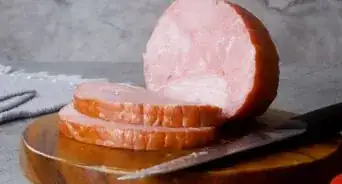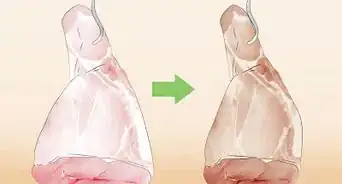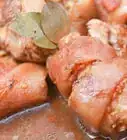This article was co-authored by Santos Aviles. Santos Aviles is a Grill Master and the Owner of Spirit of Texas BBQ in San Bernardino, California. He specializes in Central Texas-style barbeque. He serves a variety of smoked, grilled, and roasted meats, including 14-hour smoked brisket, sausage, and other cuts of beef. Spirit of Texas BBQ is also a 5-star rated business.
There are 11 references cited in this article, which can be found at the bottom of the page.
This article has been viewed 35,199 times.
"Pork butt" refers to a specific cut of pork taken from the upper portion of a pig's shoulder. Smoked pork butt is commonly used for shredded pork, but you can also serve it in slices. As a general rule, expect to cook the pork for one hour per 1 pound (16 oz) of meat.
Steps
Trimming and Trussing the Pork Butt
-
1Purchase a pork butt that has a thick, white layer of fat on top. This layer is called the “fat cap,” and it helps the meat stay juicy and moist while it cooks. You can get a bone-in or boneless pork butt—the bone-in variety helps the meat hold together while it’s cooking, but you can tie a string around a boneless one for the same results. Get a pork butt that is large enough that each person could have about 1⁄2 pound (8.0 oz) of meat, but at a minimum choose one that is at least 3–4 pounds (48–64 oz).[1]
- Look for a fat cap that is at least 1⁄4 inch (6.4 mm) thick.
- Pork butts smaller than 3–4 pounds (48–64 oz) tend to cook too fast and might dry out in the smoker.
- If you cook more meat than you need, you can freeze whatever is leftover.
-
2Let the pork butt come to room temperature so it’ll smoke more evenly. Place a refrigerated pork butt onto a cutting board on the counter for about 2-4 hours; this time might vary just depending on how big of a pork butt you purchased. You can test the temperature with an internal meat thermometer—just stick it into the middle of the pork butt to get the reading. Once it’s around 68–72 °F (20–22 °C), you’re good to go![2]
- Let a frozen pork butt thaw in the fridge for 2-3 days before you want to smoke it. Let it come to room temperature on the counter for a few hours the day-of.
- You could loosely cover the pork butt with plastic wrap or a clean dishtowel if you’re worried about it attracting pests or animals.
- Bringing the meat to room temp means you’ll get a more even cook throughout. If you were to put it on the smoker fresh out of the fridge, it would take a lot longer to cook, plus the parts on the outside that warmed up first would end up overcooked.
Advertisement -
3Trim the fat cap so it’s about 1⁄4 inch (6.4 mm) thick for the best results. Position the pork butt so the fat cap is facing up. Gently grab the edge of the fat cap and pull it up so you can see where it connects to the meat. Use a sharp knife to carefully slice through the layer of fat so there is a thin 1⁄4 inch (6.4 mm) layer left.[3]
- It may help to turn the pork butt onto its side as you’re working so that you can cut at a slight downward angle.
- Work in sections rather than trying to cut the entire fat cap at once—some areas may not need to be trimmed at all, so use your best judgment to create the evenest layer of fat possible.
- An even layer of pork fat will nicely melt into the pork butt and helps create a nice crust. Too much pork fat and the rub will have a harder time permeating the meat.
-
4Tie butcher’s twine around the pork butt if you bought a boneless one. Slide a long piece of butcher’s twine underneath the pork butt, pull it taut, and loop it into a knot. Wrap another piece of twine around the pork in the opposite direction and tie it off.[4]
- This process is called “trussing.”
- Depending on how large your pork butt is, you could add another 3-4 pieces of twine up and down the meat to hold it together well.
Seasoning the Meat
-
1Use a variety of spices to create a flavorful dry rub and magnificent crust. There are lots of different recipes out there for various rubs—some are spicy, some are smoky, and some mix in some sweetness for a mouthwatering blend. Once you’ve made a rub for your pork butt, pour half of the seasoning on top of the meat and massage it into the surface, making sure to get the sides, too. Flip the pork butt over, pour the rest of the seasoning out, and continue to rub it into the meat until the entire surface is covered.[5]
- If you don’t want seasoning all over your hands, wear a pair of powder-free latex gloves. Just make sure to toss them out when you’re done since they’ll have been in contact with raw meat.
- For example, create a sweet and smoky rub with 1/3 cup (38 grams) of smoked paprika, 1 cup (200 grams) of granulated sugar, 8 tsp (32 grams) of brown sugar, 2/3 cup (192 grams) of salt, 4 tsp (9 grams) of cracked black pepper, 1/3 cup (55 grams) of garlic salt, and 2 tsp (4 grams) of cumin.
-
2Marinate the meat in mustard for a zesty, moisture-filled pork putt. This can be as simple as coating the pork butt with about a 1⁄4 cup (59 mL) of mustard of your choice, or enough to add a thin layer over the entire cut of meat. You can add a rub on top of the mustard for extra flavor.[6]
- The mustard can help the spice rub cling to the meat better.
- Instead of using classic yellow mustard, consider trying one of these variations the next time you smoke a pork butt: dijon mustard, spicy brown mustard, whole grain mustard, or honey dijon mustard.
-
3Inject the pork with an apple marinade for extra moist meat. Not only will your pork butt become even juicier, but the flavor of the apple marinade will create a delicious and complex flavor. Use a meat syringe to inject the marinade into the meat in 3 or 4 different places, and pour any remaining marinade over the pork butt while it rests. Try this recipe:[7]
- Whisk together 2 cups (470 mL) of apple cider, 2 tbsp of dry rub (15 grams), 2 tablespoons (30 mL) of apple cider vinegar, 2 tablespoons (30 mL) of honey, 1/2 tsp (1 gram) of cayenne pepper, 1⁄4 cup (59 mL) of orange juice, 1⁄2 cup (120 mL) of lemon juice, 2 tsp (12 grams) of kosher salt, and a dash of Worcestershire sauce.
- Some purists advocate that marinating is not really necessary. If you're cooking at the right time and managing your fire, the pork butt is gonna be very moist by itself.
-
4Get adventurous and try a coffee rub if you like the flavors of espresso. Coffee and meat may sound weird, but it’s a fairly popular flavor combination. The earthiness of the coffee plays well with the meat; plus, when the other spices are added in you create a deep, complex flavor. Give this rub a try:[8]
- Mix 2 tbsp (10 grams) of freshly ground coffee, 2 tbsp (36 grams) of kosher salt, 2 tbsp (14 grams) of paprika, 1 tbsp (8 grams) of ancho chili powder, 1 tbsp (12.5 grams) of brown sugar, 1 tsp (1 gram) of oregano, 1 tsp (3 grams) of garlic powder, 1 tsp (2 grams) of onion powder, 1 tsp (2 grams) of black pepper, 1/2 tsp (1.25 grams) of cocoa powder, and 1/2 tsp (1 gram) of coriander.
-
5Let the seasoned meat sit on the counter for 1-2 hours. Either leave the meat on the cutting board or move it to a cooking tray of some sort. Cover it with a piece of plastic wrap if you’re worried about anything getting onto it.[9]
- Raw pork shouldn’t be left on the counter for more than 2 hours, max, once it has reached room temperature. It could start growing harmful bacteria if left out for too long. If you can’t start cooking it before the 2 hours have passed, place it in the fridge to keep it safe.[10]
Smoking the Meat
-
1Insert a probed meat thermometer into the pork butt if you have one. Push the thermometer into the thickest part of the pork butt so that it’s resting as close to the center as possible. If your thermometer has multiple probes, stick additional ones into the sides of the pork butt.[11]
- A probed meat thermometer has one or more probes attached to wires that lead to a monitor displaying the temperature. The wires are usually long enough that you can position the monitor outside of the smoker.
- If you don’t have a probe meat thermometer, a normal one will work fine!
- If you have a bone-in pork butt, make sure the thermometer isn’t touching the bone. That would skew the temperature reading.
- There are other ways to test that the meat is done, but an internal thermometer will give a continuous read of the internal temperature without you having to take the lid off the smoker.
-
2Prepare your smoker and get the temperature up to about 225 °F (107 °C). Some people prefer a slightly lower or higher temp, but as long as you’re in the range of about 200 to 300 °F (93 to 149 °C), your meat will cook just fine. Depending on the kind of smoker you have, you may need to add pellets, wood, wood chips, or charcoal to the machine before turning it on.[12]
- Consider trying out different types of pellets or wood to impart even more flavor to your pork butt. For example, applewood, hickory, or mesquite wood pellets would add additional flavor to the meat.
- A lower temperature will take longer to cook the meat; a higher temp will cook the meat faster, but could potentially dry out the meat a little bit.
- Pork butt cooks for a long time! Usually for over 14 hours, if not longer. Low and slow is the best way for it to be juicy, flavorful, and fall-apart tender.
- If you want to use higher temperatures, after 12 hours, remove the pork butt, wrap it in aluminum foil and put it back in the smoker for more 3 hours at 275 °F (135 °C).
- If you don’t have a smoker, you can make one yourself out of a gas or charcoal grill.
-
3Set the seasoned pork butt in the smoker and put the cover on. Position the pork so the fat cap is facing up. If you want to, you could place a drip pan underneath the meat to catch all the fat and grease as it cooks—some people like to mix that back into the meat once it’s ready to be served.[13]
- You could also add a small pan of water to the smoker. The steam can keep the wood chips from getting super dry.[14]
-
4Check the pork butt every few hours to gauge the temperature. The cooking time for any given pork butt can differ depending on the kind of smoker you’re using, how big the pork butt is, if it’s bone-in or boneless, and other variables. Generally, it takes about 1-1.5 hours for each 1 pound (16 oz) of meat to cook.[15]
- If you’re not using a meat thermometer, do the math for the weight of your pork butt and leave it alone until that time has passed. For example, if you have a 6 lb (96 oz) pork butt, let it cook for 6-9 hours. Thankfully, it’s very hard to overcook pork butt!
- If you have to lift the lid to read the temperature, try to do so sparingly. The more you lift the lid, the more heat the smoker loses, and the longer it’ll take to cook the pork butt.
-
5Remove the meat from the cooker when it’s between 195–200 °F (91–93 °C). There’s usually a stall when the meat hits about 170 °F (77 °C) and it may take some time for the temperature to continue rising. Be patient and wait—it’ll get there! Once the temp is where it should be, put on a pair of silicone gloves and transfer the meat from the smoker to a clean cutting board or tray.[16]
- The most important thing is to not let the meat get above 205 °F (96 °C) max. After that, it’ll start to get dry and tough.[17]
- If you’re not using a thermometer and have a bone-in pork butt, use a paper towel or pair of gloves to grab the bone and jiggle it. If the bone seems loose, like it could slide right out, your meat should be done.
- If you’re cooking a boneless pork butt, insert a fork into the middle of the meat and twist it about 90 degrees. If it twists easily, the meat should be done.
-
6Cover the pork butt with foil and let it rest for 20-30 minutes. It’s very important to let the meat rest before you cut into it. If you were to cut it open right away, all the juices that you worked so hard to create would flow straight out of the meat. Letting it sit helps the juices reabsorb into the meat, ensuring it’ll be tender and juicy.[18]
- While the meat is resting, you can get the rest of your meal ready!
- You could serve it on its own or on buns with a side of mac and cheese or coleslaw.
- Create flavorful tacos with pieces of avocado, thinly sliced red onions, and cilantro.
- You could even top a tray of tortilla chips with a large handful of pulled pork, add some shredded cheddar cheese and other toppings, and create awesome nachos.
-
7Pull the pork apart with forks or a pair of bear-paw shredders. Remove the foil and start pulling the meat apart so that it’s in small chunks. Forks work perfectly well for this, or you could use bear claws, a product designed to make shredding meat easier. Try to continually mix the meat so that the crust from the outside gets worked into the rest of the meat for the best flavor.[19]
- If you want, you could also slice through the meat with a knife.
- Don’t forget to throw out the bone or butcher’s twine!
- The meat is still going to be hot at this stage, so wear your silicone gloves or be careful to not get too close to it.
-
8Save leftovers in the fridge or pop them in the freezer for long-term storage. Put whatever is left into an airtight container or resealable plastic bag. In the fridge, leftovers will be good for 3-4 days. Use frozen leftovers within 2-3 months.[20]
- For safety reasons, get pork into the fridge or freezer within 2 hours of shredding it.
- Label the container with the date so you remember how long the leftovers will be good for.
Warnings
- Never let raw or cooked pork sit on the counter for more than 2 hours. Get it into the fridge before that amount of time has passed.[23]⧼thumbs_response⧽
- Be careful to hold the pork butt and knife steady when you’re trimming the fat cap. Always cut away from your body, just in case the knife were to accidentally slip.[24]⧼thumbs_response⧽
- Wear silicone gloves when handling the cooking pork butt. It’ll be extremely hot when it comes off the smoker and could cause serious burns if you grabbed it with your bare hands.[25]⧼thumbs_response⧽
Things You’ll Need
- Internal meat thermometer
- Plastic wrap (optional)
- Dishtowel (optional)
- Cutting board
- Sharp kitchen knife
- Butchers twine
- Bowl
- Measuring cups and spoons
- Powder-free latex gloves (optional)
- Drip pan
- Silicone gloves
- Forks or bear claws
- Aluminum foil
- Airtight container or resealable plastic bag
Expert Interview

Thanks for reading our article! If you'd like to learn more about cooking, check out our in-depth interview with Santos Aviles.
References
- ↑ https://whatscookingamerica.net/Pork/Pulled-Pork.htm
- ↑ https://whatscookingamerica.net/Pork/Pulled-Pork.htm
- ↑ https://www.thekitchn.com/basic-techniques-how-to-trim-t-73832
- ↑ https://youtu.be/QZR3tPqU0Dw?t=27
- ↑ https://www.foodnetwork.com/recipes/smoked-pork-butt-recipe-2102441
- ↑ https://www.foodnetwork.com/recipes/smoked-boston-pork-butt-recipe-1944104
- ↑ https://www.foodnetwork.com/recipes/patrick-and-gina-neely/apple-injected-smoked-pork-recipe-1949011
- ↑ https://www.seriouseats.com/recipes/2011/01/barbecue-coffee-rubbed-ribs-recipe.html
- ↑ https://www.foodnetwork.com/recipes/smoked-pork-butt-recipe-2102441
- ↑ https://www.stilltasty.com/fooditems/index/18059
- ↑ https://whatscookingamerica.net/Pork/Pulled-Pork.htm
- ↑ https://www.seriouseats.com/recipes/2019/07/real-barbecued-pulled-pork.html
- ↑ https://www.foodnetwork.com/recipes/smoked-pork-butt-recipe-2102441
- ↑ https://www.seriouseats.com/2019/07/how-to-make-pulled-pork-smoked-pork-shoulder.html
- ↑ https://www.seriouseats.com/recipes/2019/07/real-barbecued-pulled-pork.html
- ↑ https://www.seriouseats.com/2019/07/how-to-make-pulled-pork-smoked-pork-shoulder.html
- ↑ https://whatscookingamerica.net/Pork/Pulled-Pork.htm
- ↑ https://whatscookingamerica.net/Pork/Pulled-Pork.htm
- ↑ https://www.seriouseats.com/2019/07/how-to-make-pulled-pork-smoked-pork-shoulder.html
- ↑ https://www.stilltasty.com/fooditems/index/18059
- ↑ https://www.seriouseats.com/2019/07/how-to-make-pulled-pork-smoked-pork-shoulder.html
- ↑ https://www.thekitchn.com/leftover-pulled-pork-recipes-22949324
- ↑ https://www.stilltasty.com/fooditems/index/18059
- ↑ https://www.thekitchn.com/basic-techniques-how-to-trim-t-73832
- ↑ https://www.seriouseats.com/2019/07/how-to-make-pulled-pork-smoked-pork-shoulder.html
About This Article
To smoke a pork butt, start by soaking apple or hickory wood chips in water for 30 minutes. Then, preheat your smoker to 250 degrees Fahrenheit, and spread the soaked wood chips out over the lit charcoal. Next, place the pork butt on the smoker, close the lid, and smoke it for 3 hours. Finally, wrap the pork in foil, and continue to smoke it until it reaches an internal temperature of 200 degrees Fahrenheit. To learn how to marinate and season pork butt before smoking it, read on!




















































